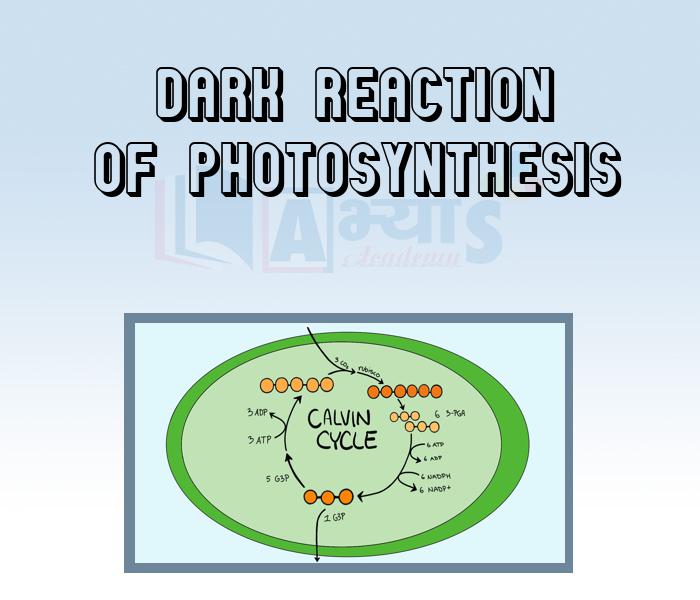Dark Reaction of Photosynthesis







Dark Reaction of Photosynthesis
The process of photosynthesis can be divided into two phases : Light phase and Dark phase
Dark phase of photosynthesis:
This phase does not require direct sunlight, but it depends on the products of the light reaction, i.e., ATP and NADPH beside and water that drive the processes leading to the synthesis of food more accurately the sugars (glucose is first product of photosynthesis).
1. C3 Pathway : - This pathway is followed by the plans when first product of fixation is a
acid, i.e., PGA.
2. C4 Pathway : - This pathway is followed or shown by the plants in which first product of fixation is a
acid, .i.e., OAA.
This is a cycle biochemical pathway of reduction of or photosynthetic carbon, cycle which was discovered by Calvin.
The Calvin cycle runs in all photosynthetic plants, no matter they show
,
or any other pathway, It occurs in stroma of the chloroplast.
Primary Acceptor of CO2 in C3 Pathway
After a long research and conducting many experiments it was concluded by the scientists that in pathway, the acceptor molecule is a 5-carbon S ketose sugar, i.e., Ribulose 5-Bisphosphate (5 RUBP). Calvin or
cycle has following three major steps Calvin or C3 cycle has many steps which are known as glycotic reversal or formation of sugar and takes place between reduction and regeneration. There are three major steps as follows
Carboxylation : - It is the most crucial step of the Calvin cycle. In this fixation of molecule takes place in the form of carboxylation of RUBP(5C). This reaction is catalysed by the enzyme RUBP carboxylase. This finally leads to the formation of two molecules of 3 Phosphoglyceric Acid (3PGA). As the RUBP carboxylase enzyme also has an activity of oxygenation.
Thus, it is more commonly known as RuBP carboxylase - oxygenase or RuBisCO.
Reduction : - Afrer the carboxylation reaction, reduction of PGA takes place through a series of reactions leading to the formation of glucose. In this step, the ATP (as energy source) and NADPH (hydrogen atom carrier) are utilised. It is to be noted that 2 molecules of ATP and 2 molecules of NADPH urilised in this step for phosphorylation and for the eduction of respectively.
Regeneration : - For the continuous and uninterrupted functioning of the Calvin cycle, there must be a regular supply of ATP, NADPH and also sufficient amount of RuBP is required.
Students / Parents Reviews [10]
It has a great methodology. Students here can get analysis to their test quickly.We can learn easily through PPTs and the testing methods are good. We know that where we have to practice

Barkha Arora
10thI have spent a wonderful time in Abhyas academy. It has made my reasoning more apt, English more stronger and Maths an interesting subject for me. It has given me a habbit of self studying

Yatharthi Sharma
10thMy experience was very good with Abhyas academy. I am studying here from 6th class and I am satisfied by its results in my life. I improved a lot here ahead of school syllabus.

Ayan Ghosh
8thAbout Abhyas metholodology the teachers are very nice and hardworking toward students.The Centre Head Mrs Anu Sethi is also a brilliant teacher.Abhyas has taught me how to overcome problems and has always taken my doubts and suppoeted me.

Shreya Shrivastava
8thAbhyas Methodology is very good. It is based on according to student and each child manages accordingly to its properly. Methodology has improved the abilities of students to shine them in future.

Manish Kumar
10thMy experience with Abhyas is very good. I have learnt many things here like vedic maths and reasoning also. Teachers here first take our doubts and then there are assignments to verify our weak points.

Shivam Rana
7thIt was good as the experience because as we had come here we had been improved in a such envirnment created here.Extra is taught which is beneficial for future.

Eshan Arora
8thMy experience with Abhyas academy is very good. I did not think that my every subject coming here will be so strong. The main thing is that the online tests had made me learn here more things.

Hiya Gupta
8thIt was a good experience with Abhyas Academy. I even faced problems in starting but slowly and steadily overcomed. Especially reasoning classes helped me a lot.

Cheshta
10thBeing a parent, I saw my daughter improvement in her studies by seeing a good result in all day to day compititive exam TMO, NSO, IEO etc and as well as studies. I have got a fruitful result from my daughter.
